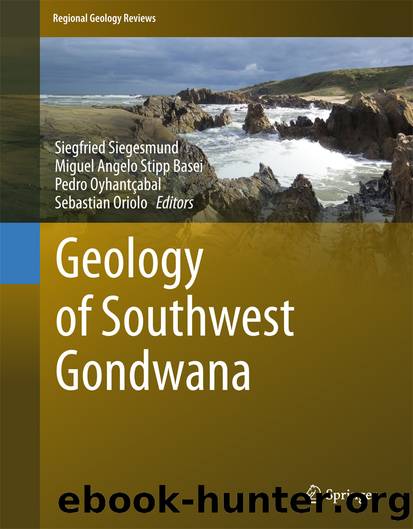Geology of Southwest Gondwana by Siegfried Siegesmund Miguel A. S. Basei Pedro Oyhantçabal & Sebastian Oriolo

Author:Siegfried Siegesmund, Miguel A. S. Basei, Pedro Oyhantçabal & Sebastian Oriolo
Language: eng
Format: epub
Publisher: Springer International Publishing, Cham
12.7.1.7 Along Orogen Shortening: ~508–505 Ma
Waning contraction in the Damara Belt at 512–508 Ma was followed by a rapid stress switch of 45° to low-strain, east–west directed shortening along the length of the belt between 508 and 505 Ma (Fig. 12.15). Late-stage upright to inclined west-vergent folds produced north–south trending crenulation cleavages with axial planar biotite in the Ugab Zone, and dome and basin fold interference in the Central Zone. North–south biotite foliations in the Ugab Zone post-date 513–511 Ma granites and sub-biotite grade folds that formed after regional cooling below 400 ℃ at 512–508 Ma, indicating a late-stage thermal anomaly and east–west shortening after ~508 Ma (Goscombe et al. 2017b). A late-stage secondary thermal anomaly accompanying east–west shortening is also recognized in the Kaoko Belt. East–west trending pegmatite dyke swarms of 508 Ma age are associated with a 507–505 Ma local thermal anomaly that reset Sm–Nd isotopics (Goscombe et al. 2005b). Central Zone cross-folding post-dates 511–508 Ma granite veins and extensional shear zones, and was interpreted at ~508 Ma (Longridge et al. 2011, 2014). East–west shortening at this time is not associated with main phase, high strain orogenesis, as would be implied by lateral escape models for the inclined dome and basin fold interference geometries in the Central Zone (e.g., Coward 1983; Oliver 1994; Kisters et al. 2004). Lateral escape models are dependent on high shear strains and a basal detachment, neither of which exists: high-strain grain-refinement fabrics (i.e., mylonite) are absent from any structural level in the Central Zone, and the basal unconformity is an unsheared, intact metapaleosoil profile (Fig. 12.10h; Goscombe et al. 2017b). Crucially, lateral escape models fail because there was no free margin at the time when crossfolds were forming; all three cratons were amalgamated and the Damara Belt was in an intraplate setting. Widespread evidence for east–west directed shortening at ~508 Ma indicates an essentially instantaneous and significant rearrangement of the stress field, inconsistent with any plausible trajectory between the Rio De La Plata, Congo and Kalahari Cratons. Consequently, far-field effects at the margin of Gondwana are the probable cause, and overlap in age with arc collisions in the Ross Orogen (Meert 2003; Boger and Miller 2004; Foster et al. 2005).
Download
This site does not store any files on its server. We only index and link to content provided by other sites. Please contact the content providers to delete copyright contents if any and email us, we'll remove relevant links or contents immediately.
Man-made Catastrophes and Risk Information Concealment by Dmitry Chernov & Didier Sornette(4734)
The Revenge of Geography: What the Map Tells Us About Coming Conflicts and the Battle Against Fate by Kaplan Robert D(3597)
Zero Waste Home by Bea Johnson(3288)
COSMOS by Carl Sagan(2950)
In a Sunburned Country by Bill Bryson(2945)
Good by S. Walden(2913)
The Fate of Rome: Climate, Disease, and the End of an Empire (The Princeton History of the Ancient World) by Kyle Harper(2434)
Camino Island by John Grisham(2383)
A Wilder Time by William E. Glassley(2362)
Organic Mushroom Farming and Mycoremediation by Tradd Cotter(2306)
Human Dynamics Research in Smart and Connected Communities by Shih-Lung Shaw & Daniel Sui(2177)
The Ogre by Doug Scott(2114)
Energy Myths and Realities by Vaclav Smil(2059)
The Traveler's Gift by Andy Andrews(2010)
Inside the Middle East by Avi Melamed(1939)
Birds of New Guinea by Pratt Thane K.; Beehler Bruce M.; Anderton John C(1906)
Ultimate Navigation Manual by Lyle Brotherton(1767)
A History of Warfare by John Keegan(1713)
And the Band Played On by Randy Shilts(1615)
